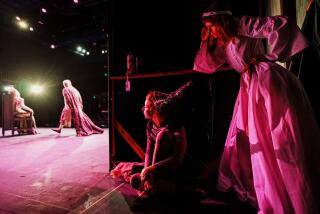Emotion From the Front Lines in ‘War Letters’
- Share via
Between “Saving Private Ryan,” “Band of Brothers” and “Black Hawk Down”--not to mention our current involvement in Afghanistan--war has been in the forefront of American culture in recent times. And now it’s appearing on another front.
“War Letters,” which had its world premiere Sunday at the Canon Theatre in Beverly Hills, is the stage version of the book “Extraordinary Correspondence From American Wars.” That impressive volume, edited by Andrew Carroll and published last May, contains 200 wartime letters written by Americans from the Civil War through Desert Storm. About 40 of those missives make it into the stage version.
For the record:
12:00 a.m. Feb. 20, 2002 FOR THE RECORD
Los Angeles Times Wednesday February 20, 2002 Home Edition Main News Part A Page 2 A2 Desk 1 inches; 28 words Type of Material: Correction
“War Letters”--In a review of “War Letters” in Tuesday’s Calendar, the title of Andrew Carroll’s book was incomplete. The book is “War Letters: Extraordinary Correspondence From American Wars.”
When reading the book, you can choose your letters. You can choose how much of each letter to read. You can even choose your war. As emotional as some of the material is, Carroll’s book is not a narrative; it goes against the grain to read these letters like a novel, cover to cover.
You can’t make those kinds of choices at “War Letters.” With a few notable exceptions, the attempt to force these letters to exist as a chronological, staged piece, war by war, remains curiously uninvolving--despite letters that contain such passionate declarations as, “I would rather write to you than eat when hungry.” Despite admirable intentions, the adaptation to the stage is nothing to write home about.
The letters used in both book and staged version are the result of a phenomenon called the Legacy Project. Carroll, now 32, wrote a 1998 letter to Dear Abby urging Americans to preserve their war correspondence, and asked the column’s readers to send him a copy of each letter. Carroll’s plea spawned an avalanche of 60,000 letters. The book made the New York Times bestseller list and a PBS documentary on the project aired last December.
The stage version, produced by Robert Redford’s Sundance Theatre and Canon Theatre’s Susan Dietz, is the latest incarnation of the project. Though the book was published before the attacks on America, the stage version not unexpectedly tags on a Sept. 11 e-mail from a New Yorker to his family
It’s easy to be impressed by the Legacy Project--and with the apparent extreme niceness of Carroll, who serves as executive director of the American Poetry & Literary Project in Washington, D.C., and sees to it that all proceeds from the book are donated to veterans’ organizations. Sundance Theatre is a nonprofit organization that supports developing artists and new work for the stage. You are doing a good thing by coming to this play.
Because of all this honorable baggage, it feels like treason to observe that “War Letters” struggles to take flight. And, while one might expect this play to seem more poignant to a nation at war, five long months of our own hideous headlines have only weakened the punch of these observations from years past. This is the not the first time someone has observed that war is hell.
The work is staged, but not dramatized, exactly. Photographs of grisly war scenes, historic moments, even of the torn, stained letters themselves, are projected across stretched fabric constructions that hint of military tents. Sound and visuals appropriate to the period--bright tie-dye patterns and student protests for Vietnam, chilling rhetoric from the Third Reich for World War II--serve as backdrop as the actors read the letters. It provides something to look at, but doesn’t alter the work’s static quality.
The play crackles to life, however, when the show’s creators take the liberty of fully dramatizing a letter, or exchange of letters, by having two characters separated by thousands of miles address each other directly--as in the case of a World War I wife Goldie Marcellus (read with wide-eyed sincerity by Nichole Pelerine), who sends her husband (Tony Abatemarco) a gushing love letter, only to have it returned with his own acerbic commentary. And while the actors sometimes go self-consciously stiff in more sober moments, they play beautifully with the letters’ often-surprising humor.
Like Eve Ensler’s “The Vagina Monologues,” which recently ended a long run at the Canon, “War Letters” will become a showcase for revolving stars; it has three permanent cast members and two guest roles--currently played by smooth Treat Williams and a hoarse-voiced Mario Van Peebles--that will rotate every few weeks to allow Hollywood actors the chance to do theater. The creators of “War Letters” have called it a work in progress, which leaves the door wide open for improvement.
*
“War Letters,” Canon Theatre, 205 N. Canon Drive, Beverly Hills. Tuesdays-Fridays, 8 p.m.; Saturdays 5 and 8 p.m.; Sundays, 3 and 7 p.m. Indefinitely. $25-$50. (310) 859-2830.
Mario Van Peebles, Treat Williams, Tony Abatemarco, Nichole Pelerine and Sybyl Walker...Ensemble
Based on “War Letters: Extraordinary Correspondence From American Wars,” edited by Andrew Carroll. Creative consultant: Andrew Carroll. Adapted for the stage by Paul Selig. Conceived and directed for the stage by Philip Himberg. Produced by Sundance Theatre. Scenic and projection design by John H. Binkley. Lighting design by Geoff Korf. Sound design and original music by Mark O’Brien. Stage manager: Ando Iovino.
More to Read
Sign up for our Book Club newsletter
Get the latest news, events and more from the Los Angeles Times Book Club, and help us get L.A. reading and talking.
You may occasionally receive promotional content from the Los Angeles Times.







